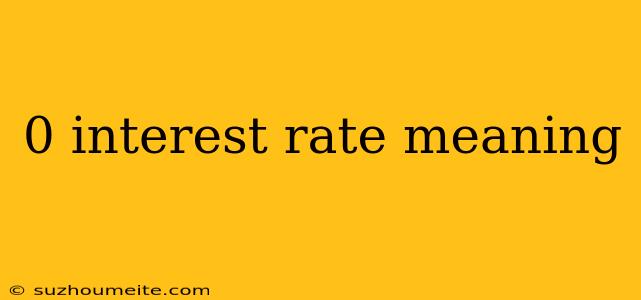0 Interest Rate Meaning: Understanding the Concept
In the world of finance, interest rates play a crucial role in shaping the economy and influencing consumer behavior. One concept that often sparks curiosity is the 0 interest rate, also known as a zero-interest rate policy (ZIRP). In this article, we will delve into the meaning of 0 interest rate, its implications, and the reasons behind its implementation.
What is a 0 Interest Rate?
A 0 interest rate means that a central bank sets its interest rate to 0% or very close to 0%. This policy is usually adopted during times of economic downturn or crisis, when the economy needs a stimulus to recover. With a 0 interest rate, commercial banks can borrow money from the central bank at no cost, making it easier for them to lend to consumers and businesses.
How Does a 0 Interest Rate Work?
When a central bank sets a 0 interest rate, it has a ripple effect on the entire economy. Here's how it works:
- Bank Lending: With access to free or very cheap money, commercial banks become more willing to lend to consumers and businesses. This increases the money supply in the economy, stimulating economic growth.
- Consumer Spending: Lower interest rates encourage consumers to take out loans for big-ticket purchases, such as homes and cars, which boosts consumer spending.
- Business Investments: Businesses can borrow money at a lower cost, making it easier for them to invest in new projects, expand operations, and hire more employees.
- Stock Market: A 0 interest rate can lead to an increase in stock prices, as investors seek higher returns in a low-interest-rate environment.
Why Do Central Banks Implement a 0 Interest Rate?
Central banks implement a 0 interest rate policy in response to certain economic conditions, such as:
- Economic Downturn: To stimulate economic growth during a recession or slowdown.
- Deflation: To combat deflation, where prices are falling, by increasing the money supply.
- Financial Crisis: To mitigate the impact of a financial crisis, such as a credit crunch or a housing market bubble.
Risks and Criticisms of a 0 Interest Rate
While a 0 interest rate can stimulate economic growth, it also has its drawbacks:
- Inequality: A 0 interest rate can widen the wealth gap, as it benefits borrowers and hurts savers.
- Inflation: Excessive money supply can lead to inflation, eroding the purchasing power of consumers.
- Misallocated Resources: Cheap money can lead to misallocated resources, as investors take on excessive risk in search of higher returns.
Conclusion
In conclusion, a 0 interest rate is a monetary policy tool used by central banks to stimulate economic growth during times of crisis or downturn. While it has its benefits, it also comes with risks and criticisms. As with any economic policy, it is essential to weigh the pros and cons and carefully consider the implications of a 0 interest rate.
